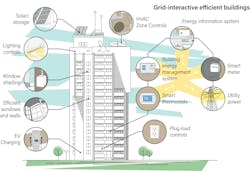Global building industry leaders commit to Decarbonization of Facilities
Staff and Wire Reports
Research and standards organization ASHRAE and 24 building industry groups, which are signatories of the Building Industry Steps Up to Address Climate Change, have pledged at the United Nations Climate Change Conference of the Parties (COP 27), to take a leadership role in decarbonizing the built environment.
Buildings, including residential and business, account for close to 40 percent of total global greenhouse gas emissions, ASHRAE President Farooq Mehboob said in a statement. Energy efficiency advocates say that dramatic improvements in electrification, insulation and lighting could be a huge driver on the road to Net Zero goals.
“The built environment is therefore one of the leading drivers of climate change,” Mehboob added. “Simultaneously, making changes to how and what we build is one of our most effective tools for mitigating and adapting to climate change and places a great responsibility on the built environment industry. This is a responsibility we earnestly accept.”
The members and organizations supported the statement. U.S. Green Building Council President and CEO Peter Templeton said that collaboration was critical to develop standards on decarbonizing building energy use.
Building energy management platform GridPoint CEO Mark Danzenbaker, while speaking outside of the ASHRAE agreement, noted that the built environment covers many different energy efficiency needs, whether it’s residential, commercial and industrial, campuses, offices, shopping malls or more. Danzenbaker stressed the need to focus on small to medium-sized buildings.
“These are often overlooked but account for the majority of buildings and present the greatest opportunities for cost-effective decarbonization today,” he said in an exclusive quote to EnergyTech. “According to the U.S. Energy Information Administration, of the more than 5.9 million commercial buildings across the U.S., over 90 percent are small- to medium-sized with footprints under 50,000 square feet – think your neighborhood pharmacy chain store, local coffee shop, fast food restaurant or convenience store."
See EnergyTech's full coverage of Energy Efficiency in the C&I Energy Transition
From Elephants to EcoStruxure: Building Remedies to understand the Facility Energy footprint
So more than 5.3 million small to medium-sized commercial buildings offer opportunities for efficiency and emissions reduction. Danzenbaker said ASHRAE was the right place to start.
“As the leading global publisher of technical industry standards for improving building service engineering, energy efficiency and sustainable practices, ASHRAE is in an excellent position to lead the charge in driving decarbonization of the built environment,” he said.
Earlier this year, the U.S. Department of Energy revealed plans to tighten energy codes for federal buildings. These moves, DOE says, could save 2.2 quadrillion Btus of energy, or the equivalent of current usage in 13 million homes, per year.
In Colorado, the state formed its first-ever Energy Code Board to oversee a revamping to get in line with the International Energy Conservation Code standards. New York also is overseeing future-forward tightening of building energy codes.
-- -- --
(Rod Walton, senior editor for EnergyTech, is a 14-year veteran of covering the energy industry both as a newspaper and trade journalist. He can be reached at [email protected]).
Follow us on Twitter @EnergyTechNews_ and @rodwaltonelp and on LinkedIn





